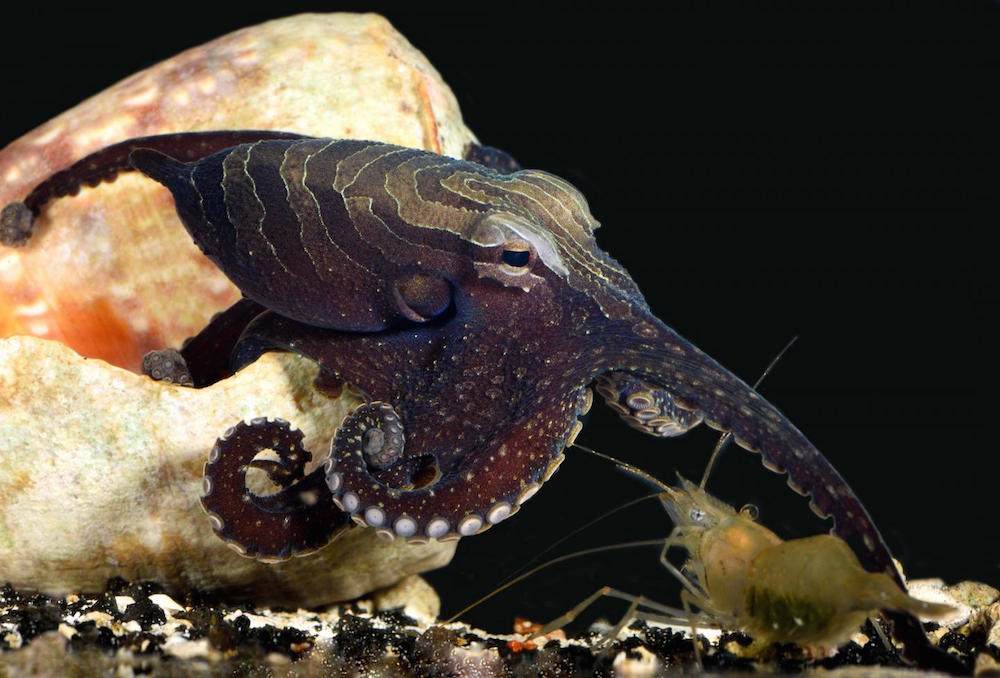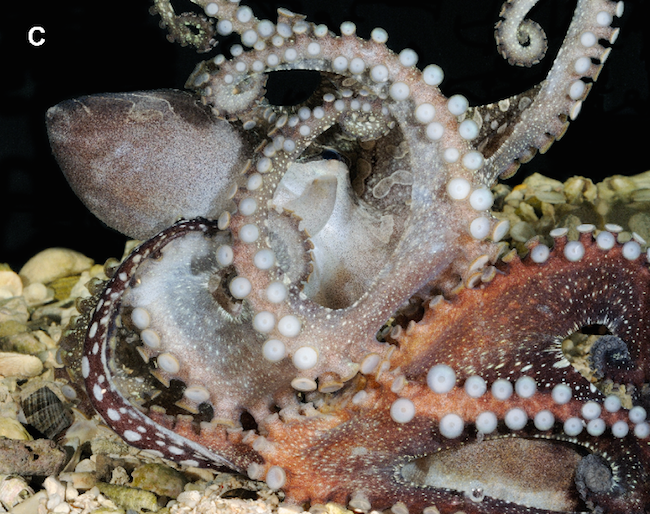Tennis Ball-Size Octopuses Suction Each Other During Sex

A very unusual octopus has scientists wondering just how well they really know the mysterious eight-armed creatures that inhabit the world's oceans.
The larger Pacific striped octopus, or LPSO for short, engages in a variety of odd behaviors — from startling prey into its outstretched arms with a sneaky tapping motion to suctioning onto its partner during mating. And if this cool behavior doesn't lure you in, the creature's appearance might. Despite its name, the "larger" striped octopus is very small, but it is bigger than its cousin, the lesser Pacific striped octopus (hence its name). And it's not just striped — it's also spotted. About the size of a tennis ball, with arms that stretch out just 8 inches (20 centimeters) or so, this striped-and-spotted octopus is definitely not a ship-swallowing sea monster.
Though scientists first observed the species in the 1970s, LPSOs have remained relatively unstudied until recently, said Roy Caldwell, a professor of integrative biology at the University of California, Berkeley, whose study outlining the LPSO's odd tendencies was published today (Aug. 12) in the journal PLOS One. [8 Crazy Facts About Octopuses]
Sneaky snacking
Caldwell and his fellow researchers spent many hours observing LPSOs in captivity, and documented the octopuses' peculiar habits. One of the strangest behaviors the researchers observed was something you might expect from, say, your prankster grandfather. You know, the one who taps you on the right shoulder and then sneaks over behind the left shoulder so that, when you look back, all you see is empty space.
To lure its preferred prey (shrimp) into its arms, the small octopus performs a similar trick. It sneaks up behind the shrimp, reaches over the prey's head and then taps with the end of its appendage. The startled shrimp instinctively swims backwards, right into the waiting arms of the hungry octopus.
"One of the things that impresses me most about this species is its great diversity of predatory behavior," Caldwell told Live Science. Not only does this striped octopus trick unsuspecting shrimp, but it also eats snails by first boring small holes into their shells with the end of its arm and then injecting its prey with a deadly, digestive fluid, he said. And despite their diminutive size, LPSOs are strong enough to break apart a clam shell and spritely enough to pounce on a quick-footed crab.
Get the world’s most fascinating discoveries delivered straight to your inbox.
But the extraordinary eating habits of this critter don't end there. Once an LPSO catches its supper, it isn't above sharing the meal with others, said Caldwell, who notes that the animal's ability to peacefully share food with other octopuses is both unusual and very exciting to biologists.
"What's interesting to us is that they tolerate another individual to the extent that they'll actually eat with it," Caldwell said. He added that the octopuses don't feed each other; it's just that they don't attack one another over food, which is unusual because solitary predators aren't typically known for sharing well with others.
Odd couple
The sharing of meals is something that tends to happen between male and female LPSOs that have recently mated, said Caldwell, who added that this seemingly generous tendency may have something to do with the species' odd breeding habits.
When a male and female LPSO get together, things get serious pretty quickly (like "move in together" serious). The lovers will share a den (usually a shell or some other enclosed space) for up to three days, the researchers observed. This is "very unusual" behavior for octopuses, said Caldwell, who noted that, for many other species of octopus, mating is sometimes a risky or even deadly ordeal, with larger females attacking (and sometimes cannibalizing) males after sex.
As such, it's pretty strange that a striped octopus female shares her meals with a mate, and vice versa, the researchers said. What's even more unusual is the manner in which the two share food. In fact, it's kind of like the way two people might share a single strand of spaghetti. One octopus will hold the food in its beak and chow down while the other nibbles at the food from the other end, the scientists found. [8 Arms! See Photos of the California Two-Spot Octopus]
And the whole beak-to-beak thing doesn't end there, according to the researchers, who found that LPSOs also prefer to mate in this position. The two octopuses spread their arms out and come together so that the suckers on the undersides of their arms suction onto one another. Then, the male deposits his sperm, known as spermatophores, into the female's "vagina," which is known as an oviduct.
After mating, the female returns to her den, where she'll lay an egg or two every day, affixing them to the walls of her den and then watching over them until they hatch. But unlike most octopus females, which mate and brood eggs just once (or at most a few times) in a lifetime, female LPSOs keep mating and brooding eggs for months (up to six months, from what the researchers observed).
The female's tendency to keep mating and eating while brooding her eggs — a behavior the researchers refer to as "extended spawning" — may have something to do with the octopus' beak-to-beak mating and eating behaviors, the researchers said. This position makes it possible for a female to keep watch on her eggs inside a den while still being able to eat and mate.
Wild idea
The larger Pacific striped octopus is clearly an unusual creature, exhibiting behaviors that biologists have never observed before in any other species of octopus. Yet, it's hard for researchers to confirm that all of these behaviors are really typical for the creatures, since scientists have never observed the animals in their natural habitat. That habitat lies about 130 to 164 feet (40 to 50 meters) below the surface of the tropical eastern Pacific (off the western coasts of Mexico, Guatemala, Nicaragua, Panama, Colombia and perhaps other countries, as well).
"The obvious thing that we have to do next is put these behaviors into the context of the natural environment," Caldwell said.
The researchers said they are also curious as to why LPSOs may have evolved to display these characteristic behaviors while other octopus species have not. However, it could be that lots of octopus species do have similar tendencies, but scientists just don't know about them yet, said Caldwell, who added that most octopus species have never been seen alive by scientists in the field. And those are just the known species; there could be others yet to be discovered, he said.
"There are over 300 known species of octopus, and more are described every year. But the fact is that while we think we know a lot about octopus behavior and physiology, everything we know comes from a handful of species," Caldwell said. "So when I tell you the LPSO is an unusual species with very unique behavior, I really don't know that."
In other words, he said, the LPSO is just one tiny, bizarre octopus in a great big, mysterious sea.
Follow Elizabeth Palermo @techEpalermo. Follow Live Science @livescience, Facebook & Google+. Original article on Live Science.



